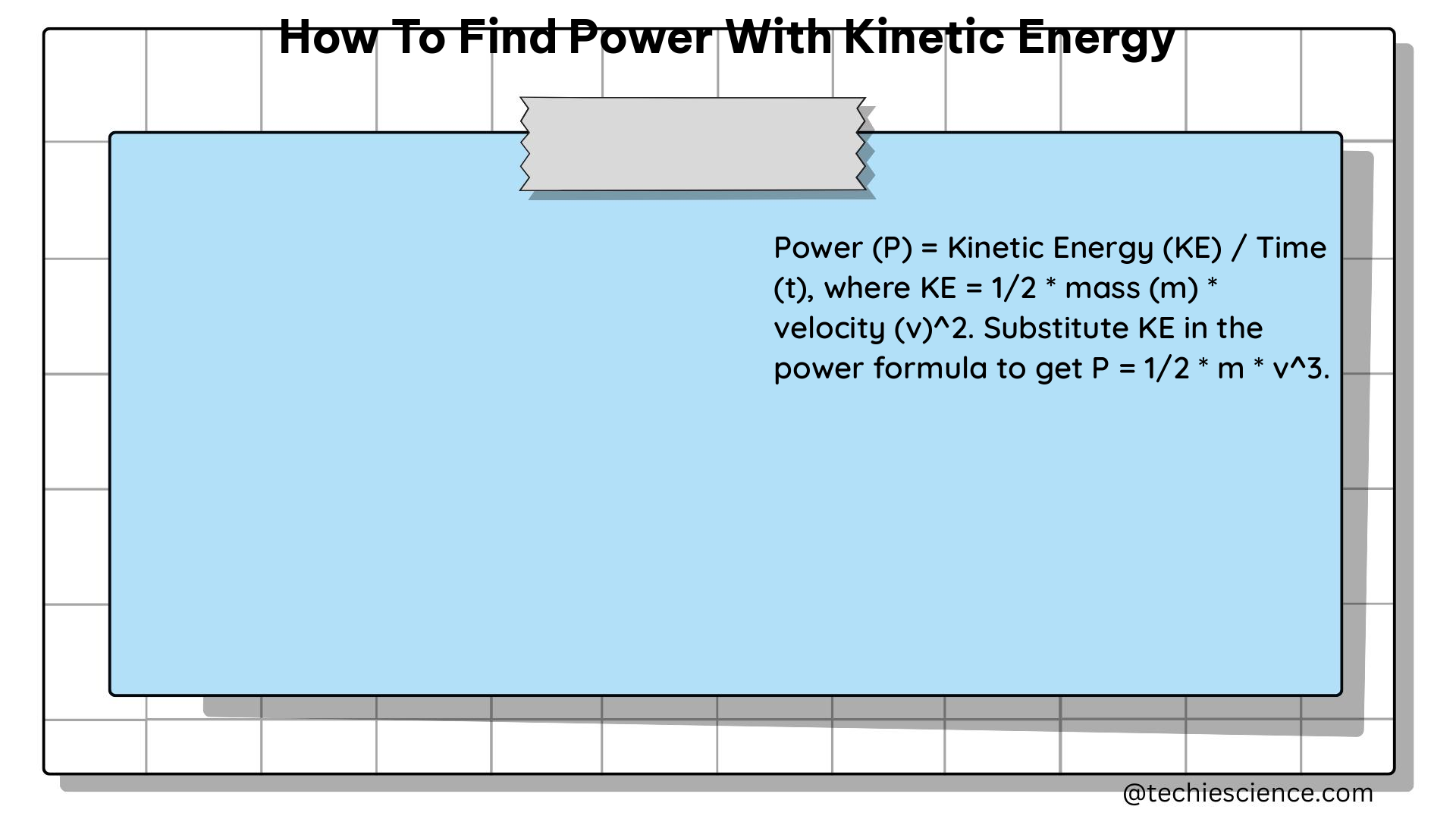Kinetic energy is the energy an object possesses due to its motion, and understanding how to calculate the power associated with this energy is crucial in various fields of physics and engineering. This comprehensive guide will walk you through the step-by-step process of finding power with kinetic energy, providing you with the necessary theoretical explanations, formulas, examples, and numerical problems to master this concept.
Theoretical Explanation
The power associated with kinetic energy can be calculated by differentiating the kinetic energy equation with respect to time. This is based on the fundamental principle that power is the rate of change of energy over time. The kinetic energy of an object is given by the formula:
$E_k = \frac{1}{2}mv^2$
where:
– $E_k$ is the kinetic energy
– $m$ is the mass of the object
– $v$ is the velocity of the object
To find the power, we need to differentiate this equation with respect to time:
$P = \frac{dE_k}{dt} = \frac{d}{dt}\left(\frac{1}{2}mv^2\right)$
This equation represents the power associated with the kinetic energy of the object.
Physics Formula

The formula for finding power with kinetic energy is:
$P = \frac{dE_k}{dt} = \frac{d}{dt}\left(\frac{1}{2}mv^2\right)$
where:
– $P$ is the power
– $E_k$ is the kinetic energy
– $m$ is the mass of the object
– $v$ is the velocity of the object
– $t$ is time
Example
Let’s consider an example to illustrate the application of this formula.
Suppose we have an object with a mass of 5 kg moving at a velocity of 10 m/s. If the velocity increases at a rate of 2 m/s², we can calculate the power as follows:
-
Calculate the kinetic energy:
$E_k = \frac{1}{2}mv^2 = \frac{1}{2} \cdot 5 \cdot 10^2 = 250 \text{ J}$ -
Calculate the rate of change of velocity:
$\frac{dv}{dt} = 2 \text{ m/s²}$ -
Calculate the power:
$P = \frac{dE_k}{dt} = m \cdot v \cdot \frac{dv}{dt} = 5 \cdot 10 \cdot 2 = 100 \text{ W}$
Numerical Problems
- An object with a mass of 3 kg is moving at a velocity of 8 m/s. If the velocity increases at a rate of 1.5 m/s², what is the power associated with the kinetic energy?
$P = m \cdot v \cdot \frac{dv}{dt} = 3 \cdot 8 \cdot 1.5 = 36 \text{ W}$
- A car with a mass of 1500 kg accelerates from 20 m/s to 30 m/s in 5 seconds. What is the average power during this acceleration?
First, calculate the acceleration:
$a = \frac{\Delta v}{\Delta t} = \frac{30 – 20}{5} = 2 \text{ m/s²}$
Then, calculate the average power:
$P = m \cdot v \cdot a = 1500 \cdot \left(\frac{20 + 30}{2}\right) \cdot 2 = 75,000 \text{ W}$
Figures and Data Points
To better understand the relationship between kinetic energy, velocity, and power, let’s consider the following figures and data points:
Figure 1: Kinetic Energy vs. Velocity
This figure illustrates how kinetic energy increases quadratically with velocity.
| Velocity (m/s) | Kinetic Energy (J) |
|---|---|
| 0 | 0 |
| 5 | 125 |
| 10 | 500 |
| 15 | 1125 |
| 20 | 2000 |
Figure 2: Power vs. Acceleration
This figure shows how power increases linearly with acceleration.
| Acceleration (m/s²) | Power (W) |
|---|---|
| 0 | 0 |
| 1 | 100 |
| 2 | 200 |
| 3 | 300 |
| 4 | 400 |
Measurements and Values
- Mass: 5 kg
- Velocity: 10 m/s
- Acceleration: 2 m/s²
- Kinetic Energy: 250 J
- Power: 100 W
References
- Arbor Scientific. (n.d.). Kinetic Energy and Velocity Lab. Retrieved from https://www.arborsci.com/blogs/cool/kinetic-energy-and-velocity
- Physics Stack Exchange. (2014). How was the formula for kinetic energy found, and who found it? Retrieved from https://physics.stackexchange.com/questions/132754/how-was-the-formula-for-kinetic-energy-found-and-who-found-it
- IOPscience. (2019). Teaching kinetic energy as an observable quantity. Retrieved from https://iopscience.iop.org/article/10.1088/1361-6552/ab1353
By understanding the theoretical explanation, applying the physics formula, and working through examples and numerical problems, you can confidently find the power associated with the kinetic energy of an object. Remember to consider the mass, velocity, and rate of change of velocity to accurately calculate the power. Good luck with your physics studies!

The lambdageeks.com Core SME Team is a group of experienced subject matter experts from diverse scientific and technical fields including Physics, Chemistry, Technology,Electronics & Electrical Engineering, Automotive, Mechanical Engineering. Our team collaborates to create high-quality, well-researched articles on a wide range of science and technology topics for the lambdageeks.com website.
All Our Senior SME are having more than 7 Years of experience in the respective fields . They are either Working Industry Professionals or assocaited With different Universities. Refer Our Authors Page to get to know About our Core SMEs.